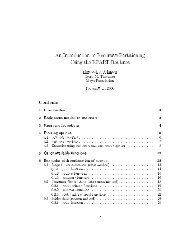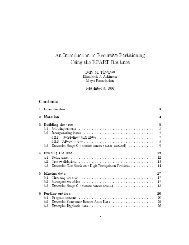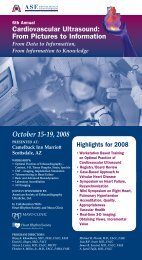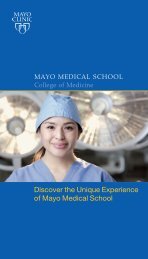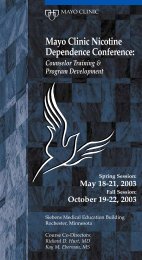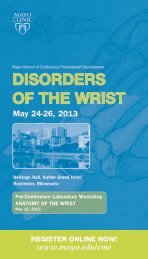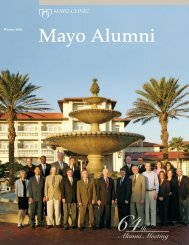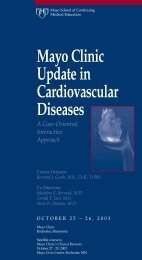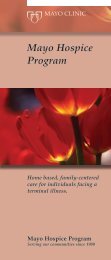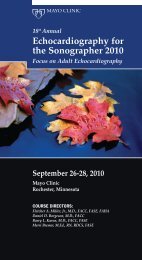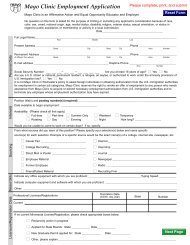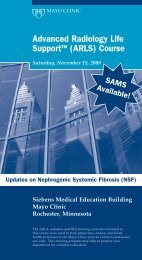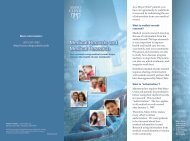Mayo Alumni Magazine 2002 Spring - MC4409-0402 - Mayo Clinic
Mayo Alumni Magazine 2002 Spring - MC4409-0402 - Mayo Clinic
Mayo Alumni Magazine 2002 Spring - MC4409-0402 - Mayo Clinic
Create successful ePaper yourself
Turn your PDF publications into a flip-book with our unique Google optimized e-Paper software.
Dr. Gunderson received his medical<br />
degree from the University of<br />
Kentucky and his residency training<br />
in Salt Lake City. He was involved in<br />
gastrointestinal cancer research at the<br />
University of Minnesota and taught<br />
at the University of Utah and<br />
Harvard Medical School. He joined<br />
the staff of <strong>Mayo</strong> <strong>Clinic</strong> in Rochester<br />
in 1980 and moved to Scottsdale<br />
in 2001.<br />
<strong>Mayo</strong> <strong>Clinic</strong> files legal<br />
challenge to Surface<br />
Transportation Board’s<br />
decision<br />
<strong>Mayo</strong> <strong>Clinic</strong> filed a legal challenge<br />
in federal district court in Washington,<br />
D.C., challenging the adequacy of the<br />
Surface Transportation Board’s (STB)<br />
administrative process and decision<br />
to allow the Dakota, Minnesota &<br />
Eastern (DM&E) Railroad to upgrade<br />
and expand rail lines to haul coal from<br />
Wyoming. The court determined that<br />
the matter should be heard in the<br />
Eighth District in St. Louis.<br />
The DM&E’s plan could allow up<br />
to 34 mile-long coal trains to run<br />
through downtown Rochester each<br />
day, within a few hundred feet of<br />
<strong>Mayo</strong>’s facilities. Hugh Smith, M.D.,<br />
chair of the <strong>Mayo</strong> <strong>Clinic</strong> Board of<br />
Governors in Rochester, said <strong>Mayo</strong> is<br />
especially disappointed with the<br />
process by which the STB made its<br />
decision.<br />
“Specifically, we’re disappointed<br />
that the STB chose to dismiss concerns<br />
about the negative effect of the<br />
proposal on community safety,<br />
quality of life and economic and<br />
business performance, along with<br />
any discussion of alternate routes,”<br />
he says.<br />
In an announcement, Dr. Smith<br />
presented the following:<br />
Community safety — The STB<br />
chose to dismiss the threat posed to<br />
the people of Rochester and those<br />
who visit here. The threat posed to<br />
our community’s safety and the safety<br />
of <strong>Mayo</strong> <strong>Clinic</strong>’s patients and visitors<br />
is real. We remain concerned about<br />
the safety of Rochester residents living<br />
near the tracks and of our hospitalized<br />
patients because of the transport of<br />
hazardous chemicals and coal.<br />
On Jan. 18, a train derailment one<br />
mile outside Minot, N.D.,<br />
illustrated the nature of this threat<br />
to public safety. The derailment killed<br />
one man and sent 300 people<br />
to the hospital. A cloud of dangerous<br />
anhydrous ammonia drifted into parts<br />
of the city forcing Minot’s primary<br />
public hospital to shut down its air<br />
handling system. Had the derailment<br />
occurred closer to the hospital,<br />
patients would not have been able to<br />
be evacuated. Extra hospital staff<br />
would not have been able to come to<br />
the hospital because of the threat<br />
presented by the toxic cloud of<br />
anhydrous ammonia.<br />
If an incident similar to the one<br />
in Minot occurred in Rochester, the<br />
repercussions could be disastrous for<br />
our patients and the community.<br />
Almost 1,500 hospitalized patients<br />
receive life-saving care in close<br />
proximity to the DM&E line.<br />
Many are treated in intensive care<br />
units. It would be impossible to safely<br />
evacuate patients in these units. Yet,<br />
such a disaster would necessitate<br />
evacuation of Rochester hospitals at<br />
the very moment when prompt,<br />
critical, life-saving care was needed to<br />
treat mass casualties occurring in the<br />
community. Beyond the STB’s<br />
assessment of the proposal’s impact<br />
on safety, we have concerns in the<br />
following areas:<br />
• Alternate routes — The STB’s<br />
decision states that alternate<br />
routes are not feasible because of<br />
southeastern Minnesota’s karst<br />
geology. Interstate 90 and miles of<br />
other highway and railroad tracks<br />
throughout southeastern<br />
Minnesota are constructed on<br />
similar karst geology. Rail lines<br />
and highways have overcome this<br />
geologic challenge in many other<br />
parts of the country.<br />
• Quality of life — Up to 34 coal<br />
trains each day will have a<br />
significant negative impact on<br />
overall quality of life, causing lifethreatening<br />
delays in emergency<br />
response and increased noise<br />
levels of up to 70 decibels along<br />
the line from one end of the city to<br />
the other.<br />
• Our economy and business<br />
community — Many of our<br />
patients tell us that they choose to<br />
come to <strong>Mayo</strong> <strong>Clinic</strong> because they<br />
feel Rochester is a safe, quiet and<br />
clean city. If just one percent of<br />
<strong>Spring</strong> <strong>2002</strong> <strong>Mayo</strong> <strong>Alumni</strong> 25



